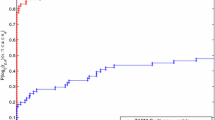Abstract
A trajectory following method for solving optimization problems is based on the idea of solving ordinary differential equations whose equilibrium solutions satisfy the necessary conditions for a minimum. The method is `trajectory following' in the sense that an initial guess for the solution is moved along a trajectory generated by the differential equations to a solution point. With the advent of fast computers and efficient integration solvers, this relatively old idea is now an attractive alternative to traditional optimization methods. One area in control theory that the trajectory following method is particularly useful is in the design of Lyapunov optimizing feedback controls. Such a controller is one in which the control at each instant in time either minimizes the `steepest decent' or `quickest decent' as determined from the system dynamics and an appropriate (Lyapunov- like) decent function. The method is particularly appealing in that it allows the Lyapunov control system design method to be used `on-line'. That is, the controller is part of a normal feedback loop with no off-line calculations required. This approach eliminates the need to solve two-point boundary value problems associated with classical optimal control approaches. We demonstrate the method with two examples. The first example is a nonlinear system with no constraints on the control and the second example is a linear system subject to bounded control.
Similar content being viewed by others
References
Anderson, M.J. and Grantham, W.J. (1989), Lyapunov optimal feedback control of an inverted pendulum, J. of Dynamic systems, Measurement, and Control 111(4), 554–558.
Grantham, W.J. (1981), Controllability conditions and effective controls for nonlinear systems. In: Proc. IEEE Conf. On Decision and Control, San Diego, CA.
Grantham, W.J. (1982), Some necessary conditions for steepest descent controllability. In: Proc. American Control Conf., Alexandria, VA.
Grantham, W.J. (1986), ODESSYS: ordinal differential equations simulation system for nonlinear optimization, optimal controls, and differential games. In: Proc. Third IEEE Computer Aided Control Systems Design Conf., Arlington, VA.
Grantham, W.J. and Chingcuanco, A.O. (1984), Lyapunov steepest descent control of constrained linear systems, IEEE Trans. on Automatic Control AC-29(8), 740–743.
Gutman, S. and Leitmann, G. (1976), Stabilizing feedback control for dynamical systems with bounded uncertainty. In: Proc. IEEE Conf. On Decision and Control.
Reklaitis, G., Ravindran, V. and Ragsdell, K. (1983), Engineering Optimization Methods and Applications. Wiley, New York.
Vincent, T. and Grantham, W. (1997), Nonlinear and Optimal Control Systems, Wiley, New York.
Vincent, T.L. (2000), Optimization by way of the trajectory following method. In: X.Q. Yang, et al. (eds), Progress in Optimization, Kluwer Academic Publishers, 239–254.
Author information
Authors and Affiliations
Rights and permissions
About this article
Cite this article
Vincent, T.L., Grantham, W.J. Trajectory Following Methods in Control System Design. Journal of Global Optimization 23, 267–282 (2002). https://doi.org/10.1023/A:1016530713343
Issue Date:
DOI: https://doi.org/10.1023/A:1016530713343




